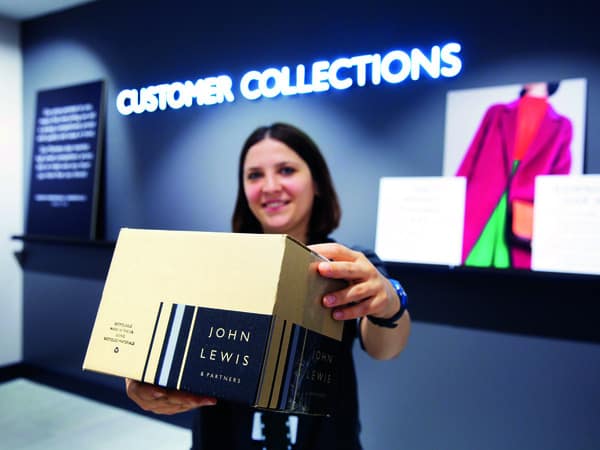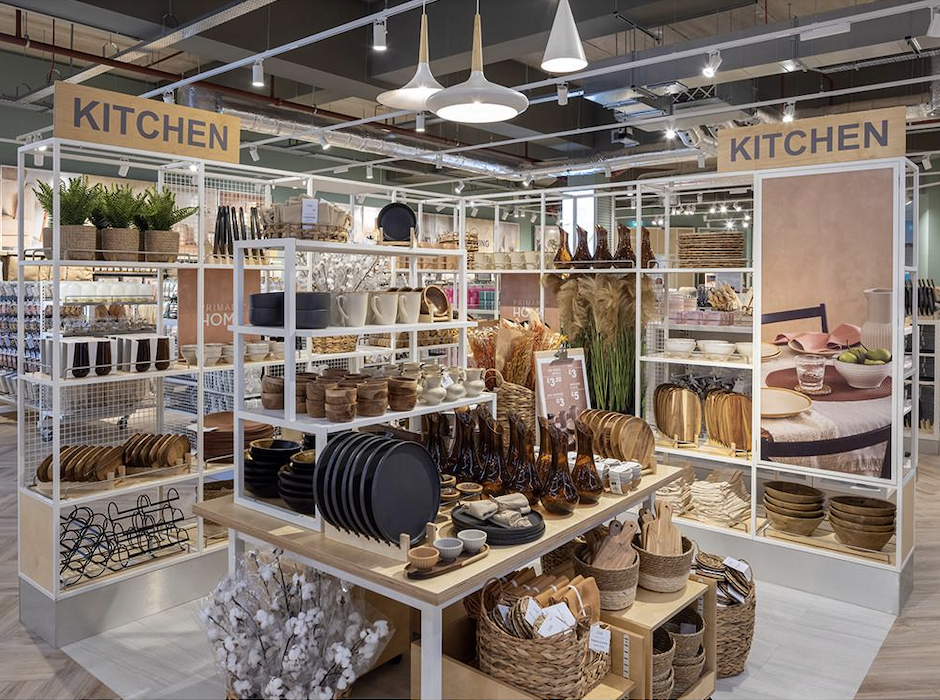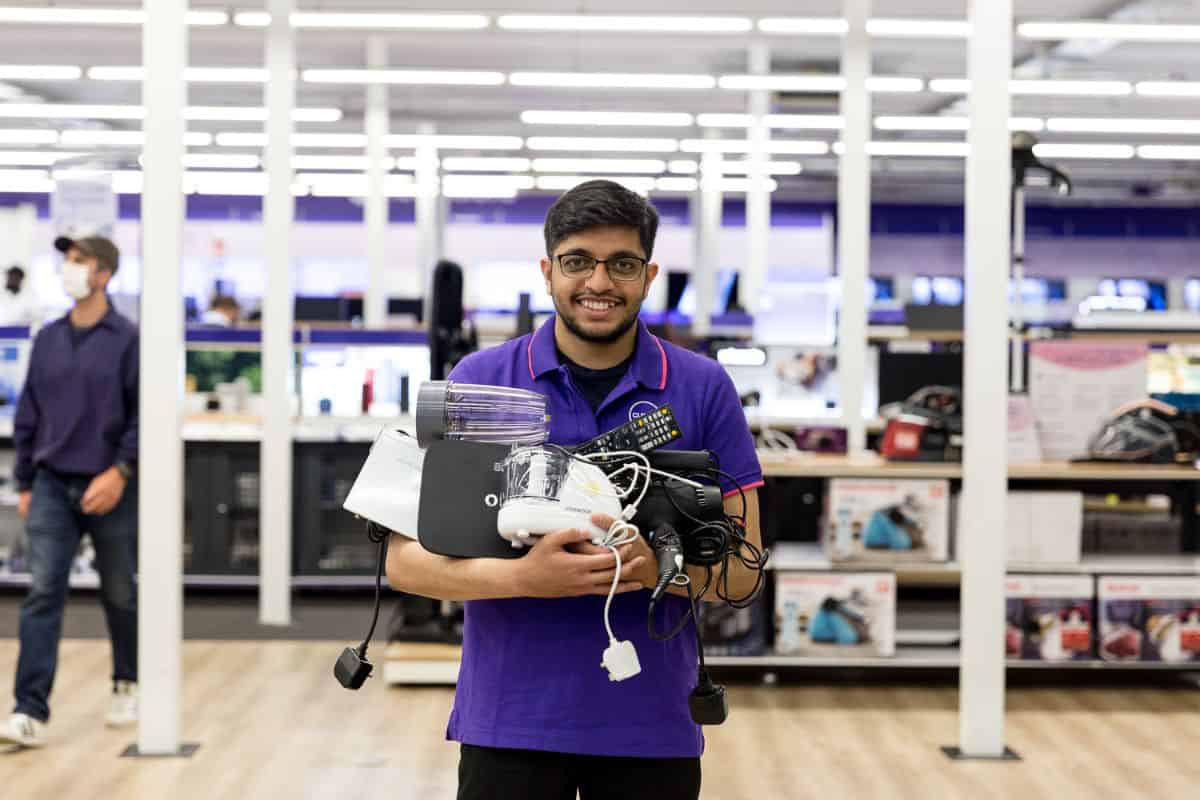John Lewis has reported record sales in a year in which its stores were closed for 10 weeks and it had 16 fewer stores than before the Covid-19 pandemic started. That reflects the shift to online that means some 67% of sales were online in its latest financial year, with only 33% taking place in-store. That’s 25 percentage points (pp) ahead of the 42% of sales that took place online two years earlier, but 8pp lower than the 75% that were online a year earlier.
Waitrose sales fell back in the second half of the year after customers returned to “more normal buying patterns” – and went out to eat more often. Some 16% of sales took place online, and 83% in-store, with 1% of sales via Deliveroo.
But one-off costs mostly related to the closures of eight stores and a distribution centre as well as job losses in management and head office, meant that at the bottom line, pre-tax losses came in at £26m – 95% lower than a year earlier.
The financials
The update came as John Lewis reported record full-year sales of £4.9bn. That’s up 4% on the previous year, and 8% ahead on a like-for-like basis (LFL) that strips out the effect of store openings and closures. Sales were up by 2% (10% LFL) on the previous year. Waitrose sales of £7.5bn fell 1% on last year, but rose by 1% LFL.
Sales at parent company John Lewis Partnership came in at £12.5bn in the year to January 29 2022, 1% up on last year, with revenue of £10.84bn up 0.6% when VAT and returned sales were excluded.
The higher costs of online fulfilment, along with supply chain issues and Covid-19 staff absences reduced trading operating profits at Waitrose by 11%, to £1bn. John Lewis trading operating profits rose by 37% to £758m.
John Lewis Partnership top-line profits – before tax and exceptional items – came to £181m, 38% – or £50m – up on last year, and 159% (£111m) higher than two years ago. At the bottom line, pre-tax losses of £26m were 95% (£491m) down last year’s £517m pre-tax loss, after one-off costs of £161m and £46m to pay a staff bonus. The partnership is giving staff a 2% pay rise as it pays the voluntary real living wage nationwide in light of the cost of living squeeze, and a bonus of 3%, equivalent to 1.5 weeks’ pay. The executive team is donating its share of the bonus to the British Red Cross.
Last year’s losses were particularly large because a write down in the value of its stores accounted for most of its £648m one-off costs. This year’s one-off costs included restructuring costs, the cost of exiting property leases and a small write down in the value of the continuing John Lewis store. That was followed this year by a smaller write down in their value. In its latest financial year, losses narrowed as the retail group cut costs by £170m through steps including closing eight John Lewis stores and a delivery hub, while reducing numbers in management and headquarters teams. These actions, says the partnership, have made it sustainable for the future.
John Lewis Partnership chairman Sharon White says in today’s full-year statement: “We have made a good start to our Partnership Plan but are only one year through our five year transformation. Looking ahead, we see continued uncertainty from global events, affecting the economic environment, our customers, Partners and society. As inflation and energy prices rise, our customers face higher living costs. While this creates uncertainties as we look ahead, we remain focused on investing significantly in our Partnership Plan to transform and grow our business.”
John Lewis multichannel strategy
Some 67% of John Lewis sales took place online in its latest financial year, with 33% in stores. In the previous year, which included two pandemic lockdowns in which all its stores were temporarily closed, 75% of sales were online and 25% in-store. Before the pandemic, 42% of sales were online, and 58% in-store.
More than a fifth (23%) of online sales took place via the John Lewis app. That’s up from 16% the previous year, following a relaunch of the app. John Lewis says customers who shop on its app spend more than those using other channels.
GlobalData senior retail analyst Zoe Mills says John Lewis has seen online sales decline by about about 8% since last year, but that the proportion of sales taking place online remains 25 percentage points ahead of pre-pandemic levels. She says that while the new John Lewis app is a “vast improvement on its previous iteration, more should be done to drive engagement online”.
Improvements to the John Lewis customer loyalty programme are among the areas in which John Lewis plans to invest £119m earmarked for digital, distribution and stores in the coming year. The department store will also spend £500m on its new pledge of everyday quality and value, which is set to replace its ‘never knowingly undersold’ promise in the summer. Improvements to its customer loyalty programme are also to be introduced.
The retailer says online capacity will increase when its Fenny Lock distribution centre opens this summer. It has also expanded its click and collect service to be available at more than 1,000 sites.
Operating profits at John Lewis came in at £758m, 37% higher than last year.
Brand strategy
Sales of its Anyday range, focused on value and quality, have reached more than £120m, with more than 2m shoppers buying from the range – of whom 93% bought John Lewis products from other price ranges.
The retailer introduced 230 new brands to give shoppers more choice.
Waitrose multichannel strategy
Online sales at Waitrose grew to account for 17% of total sales in its latest financial year. That’s up from 14% a year earlier, and 5% in 2019/20. The supermarket now has capacity for up to 280,000 waitrose.com orders a week, up 20% on last year following the opening of a new distribution centre in Greenford.
Waitrose’s partnership with Deliveroo, now available in more than 150 Waitrose stores, “frequently” generates weekly sales of £1m. The two partners are now trialling 10 minute delivery through Deliveroo Hop and a dedicated Waitrose dark store in Bermondsey.
Last year, Waitrose invested £90m in expanding its ecommerce capacity and in 18 shop refurbishments. In its current financial year, Waitrose will invest £72m in its digital services and distribution and £55m to complete the refurbishment of 23 Waitrose shops. It will also offer savings on the products customers buy most through its MyWaitrose loyalty scheme.
Waitrose now sells John Lewis products in dedicated sections in 38 stores, following trials to find out how best to bring John Lewis products into the supermarkets, and they will be sold in a further 49 shops by the end of 2022/23.
However, Waitrose operating profits have been “significantly diluted by inflationary pressures within supply chains, higher levels of absence due to Covid and higher fulfilment costs as a result of the level of online trade”. Waitrose operating profits came in at £1bn, down 11% from last year.
Waitrose and John Lewis are ranked Top50 in RXUK Top500 research.









